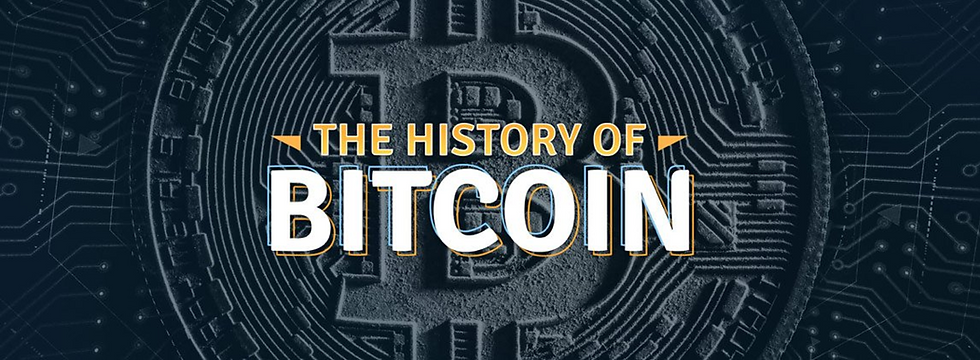
Before knowing what is Bitcoin, What is Money..? Well, Money = Value/transferring value
Throughout humankind, this value is getting changed;
➔ The Barter System came into being.
➔ Then, nickel and copper came into existence.
➔ Gold came to be the most valuable after this.
➔ Now, money is the note and physical currency printed by govt. of different countries.
Later, research claimed the currency should be
1. Limited and
2. Decentralized; for the value to never decrease. That is how cryptocurrency came into being..!
Mid Era -
After the fall of Bitcoin's price, what you could call a "greater mature market" arose around the cryptocurrency.
CONCISE VIEW OF BITCOIN’S BEING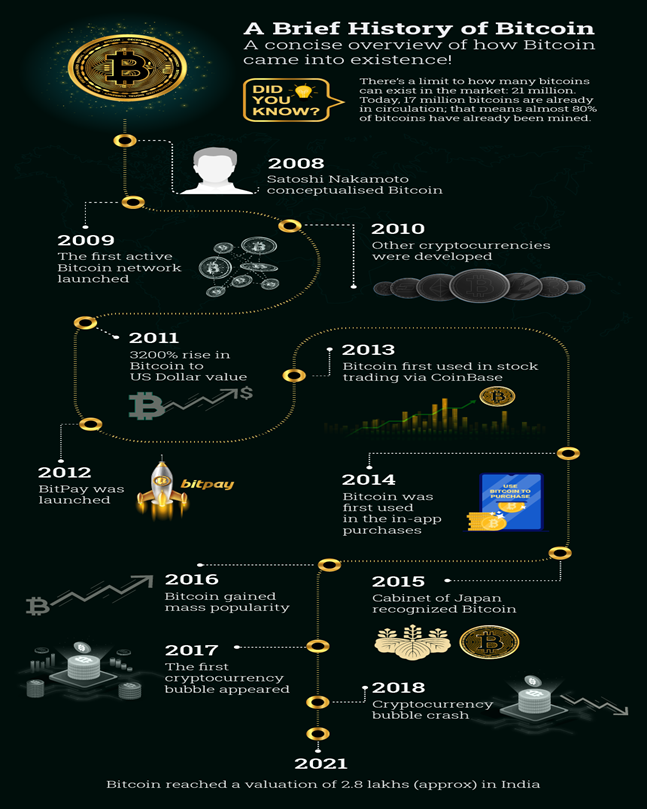
Bitcoin (BTC) is a peer-to-peer cryptocurrency that aims to function as a means of exchange, independent of any central authority. These currencies are transferred electronically in a much more secure, verifiable, and immutable way.
● Launched on January 3, 2009., BTC is the first virtual currency to solve the double-spending issue by timestamping transactions before broadcasting them to all Bitcoin network nodes. The Bitcoin Protocol offered a solution to the Byzantine Generals' Problem with a blockchain network structure, a notion first created by Stuart Haber and W. Scott Stornetta in 1991.
● Mining the first block, called the genesis block, also called Block 0, marked the launch of the very first blockchain. It provides a reference point for other blocks on the chain.
● Bitcoin’s whitepaper was published pseudonymously in 2008 by an individual, or a group, with the pseudonym Satoshi Nakamoto, whose underlying identity is still not verified.
● The Network validators referred to as miners, participate in the SHA-256d-based Proof-of-Work consensus mechanism to determine the next global state of the blockchain. Its network has a target block time of 10 minutes and a maximum supply of 21 million tokens, with a decaying token emission rate. The initial reward for a block was 50 BTC per block.
● With a block size limit capped at 1 megabyte, the Bitcoin Protocol has supported both the Lightning Network, a second-layer infrastructure for payment channels, and Segregated Witness, a soft-fork to increase the number of transactions on a block, as solutions to network scalability.
HISTORICAL DAILY PRICES (IN USD)
-LAST 5YRS
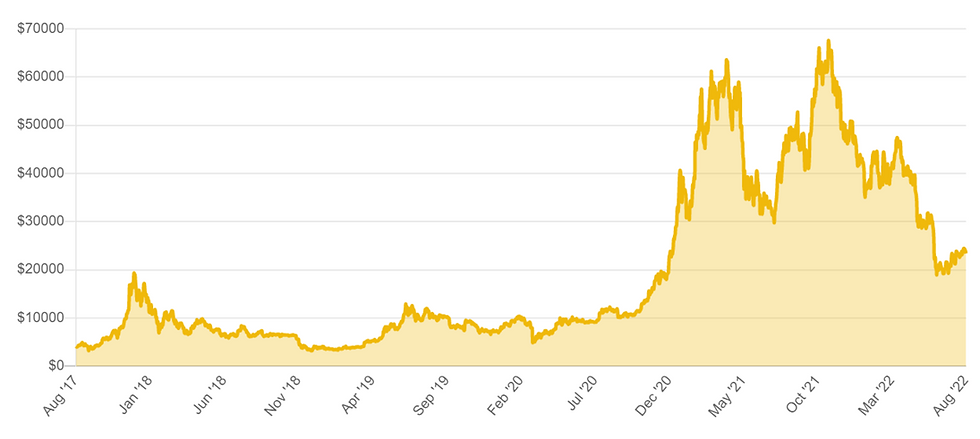
Medieval History:
The People’s Bank of China initiated the most impactful regulations with three separate actions:
– In December’13, the bank prohibited financial institutions from using Bitcoin.
– In September’17, it issued a complete ban on the use of Bitcoin
– On June’21, it implemented a crackdown on significant cryptocurrency miners.
After each of these instances, the charge of Bitcoin halved. Despite those policies, the rate of Bitcoin continues to be supported and trending upward in institutions and countries permitting using cryptocurrency.
The two most recent examples – via the Tala, Circle, and Stellar improvement Foundations’ partnership with Visa, in addition to El Salvador’s rules to make Bitcoin legal soft.
Some famous personality says about cryptocurrency/BitCoin:
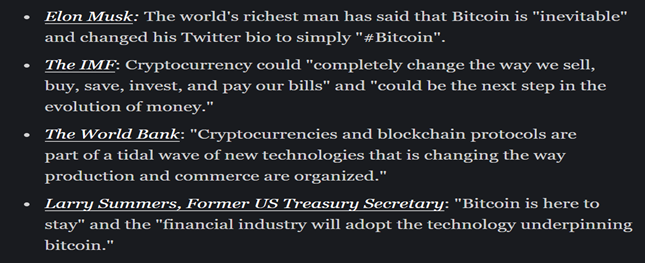
“Because of these developments, the market for Bitcoin has become relatively mature. Smart and efficient exchanges exist, and core institutional-grade players are adopting the necessary measures to create a sustainable and viable market for the trading and investing of Bitcoin and other cryptocurrencies” – GARRETTE FURO.
"Bitcoin isn't a get rich quick scheme, it's a don't get poor slowly scheme." – JAMESON LOPP.
Today, one Bitcoin is worth about $37,000. It's a long way from its all-time high but a long way from its post-peak bottom in 2018 of just over $3,000.\
As people and vendors become more familiar with cryptocurrencies, the list of goods and services that can be purchased with Bitcoin and other cryptocurrencies grows daily. Insurance, consumer goods, luxury watches, and event tickets are among the items that virtual currency buys.
How is a Bitcoin mined ?
As Bitcoin is a decentralized system, it needs a decentralized workforce to keep it running. Miners are this workforce, which helps to keep the infrastructure running. The miners are paid for their services in newly minted Bitcoins; by inflating the money supply, i.e., a tax on everyone who has Bitcoins. A miner takes a bunch of recent Bitcoin transactions and bundles them into one block. Miners solve a proof of work every block. For solving the PoW task, miners are awarded a bit of BTC (currently 6.25 BTC per block).
It started with just Satoshi mining blocks on his PC. Now, they are being rewarded 50 bitcoins per block. That is the only way a bitcoin can be created - through mining.

Minting is also part of mining, where a new block is hashed for the first time in the Bitcoin network and triggers a minting of new coins. Minting only refers to new coins coming into existence. The way coins are minted in this protocol does not require mining, but rather staking.
Mining increases the bitcoin network's security and fights fraud by calculating what's effectively a checksum for transactions. By contributing their computing power to the bitcoin network for mining, individuals are rewarded with newly minted bitcoins by the community. It also provides a way to distribute new bitcoins fairly.
Difference between Bitcoin (BTC) and Bitcoin Satoshi’s Vision (BSV)
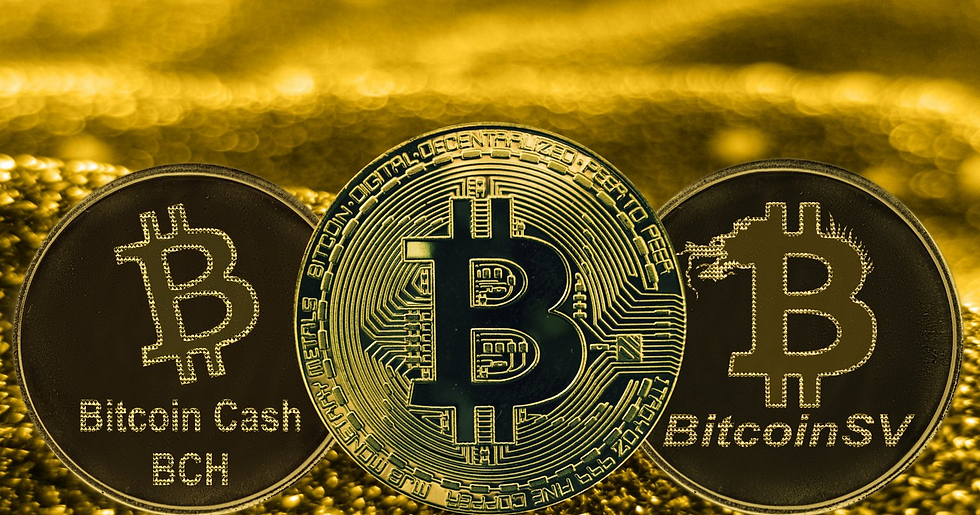
The three prominent implementations of Bitcoin (BTC), Bitcoin Cash (BCH), and Bitcoin Satoshi's Vision (BSV) have been vying for supremacy since 2017.
The three coins share some familiar similarities as they belong to the same network, but they are very different as they pursue diverse goals.
❖ On the surface, the most noticeable difference between BTC (Bitcoin Core) and BSV (Bitcoin Satoshi Vision) is the choice of block size. BTC claims small blocks (1 megabyte per block), while BSV opted for large blocks with unlimited block sizes.
❖ On the other hand, choosing BSV is to maximize the system's transaction capacity. On the other hand, choosing BTC is ill-advised and even misleading. This is because the BTC gains popularity by creating the illusion of decentralization through a concentrated suppression of economic competitiveness.
BCH (Bitcoin Cash) actually started as a so-called hard fork of Bitcoin. A hard fork is basically a split of a blockchain carried out by a specific group within the crypto community.
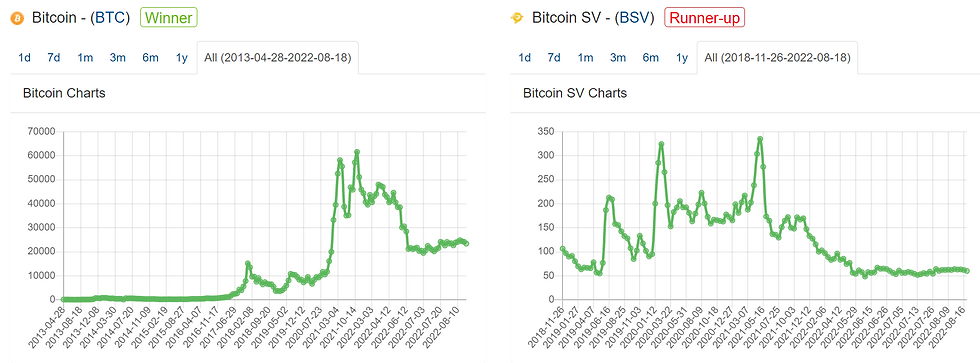
In this case, the Bitcoin Cash (BCH) founder had concerns about the scalability of his original Bitcoin network, so he decided to launch his own version.
The Blockchain Production
The Bitcoin protocol utilizes the Merkle tree data structure in order to organize hashes of numerous individual transactions into each block. This concept is named after Ralph Merkle, who patented it in 1979.
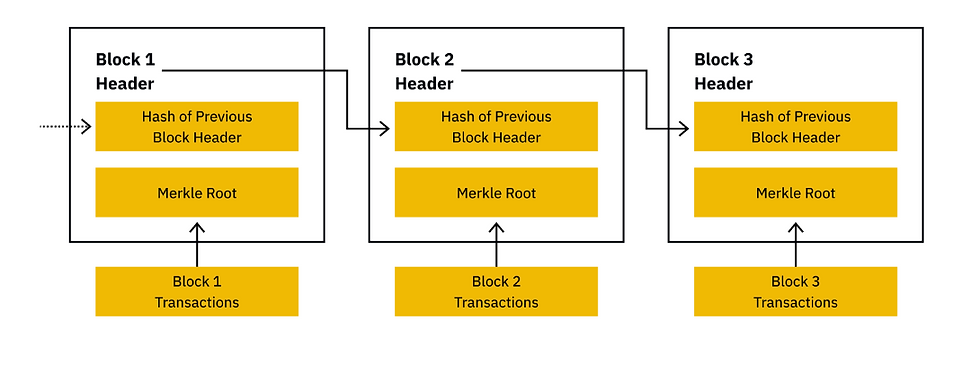
The Unspent Transaction Output (UTXO) Model
A UTXO transaction works like a cash payment between two parties.
GOLD vs BITCOIN


The Project Team
Bitcoin is an open source project, with a global development community and over 600 contributors on GitHub at the time of writing.

It’s estimated that the last satoshi will be mined around the year 2140.
Author; Ishika Bajaj | Analytics Associate | AQcomply


コメント